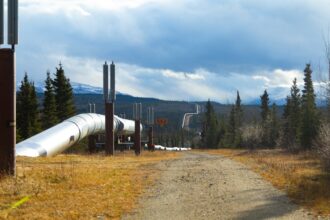The Nord Stream pipeline, a critical infrastructure project designed to transport natural gas from Russia to Europe, became the center of international attention following a series of unexplained blasts in late September 2022. These explosions not only disrupted the flow of gas but also raised significant concerns regarding energy security in Europe, particularly in the context of rising geopolitical tensions. The blasts occurred in the Baltic Sea, where two major pipelines, Nord Stream 1 and Nord Stream 2, were located.
The incident sparked a flurry of speculation and debate about the implications for energy supply, environmental safety, and international relations. As the dust settled, the ramifications of the blasts extended far beyond immediate energy concerns. The incident highlighted vulnerabilities in critical infrastructure and underscored the complex interplay between energy dependence and national security.
With Europe grappling with an energy crisis exacerbated by the ongoing conflict in Ukraine, the Nord Stream blasts served as a stark reminder of the fragility of energy systems and the potential for sabotage in an increasingly polarized world. The investigation into the cause of the explosions would reveal not only technical details but also broader geopolitical dynamics at play.
Key Takeaways
- Nord Stream Blasts have caused significant concern and attention globally.
- Initial reports and reactions to the blasts were filled with shock and speculation.
- Investigating the cause of the blasts has been a top priority for authorities.
- Key findings have shed light on the truth behind the Nord Stream Blasts.
- The environmental impact of the blasts is a major concern for the affected areas.
The Initial Reports and Reactions
In the immediate aftermath of the blasts, initial reports emerged detailing significant damage to the Nord Stream pipelines. Seismologists recorded unusual underwater explosions, which were later confirmed by various national agencies. The Swedish Maritime Administration reported gas leaks, prompting urgent responses from neighboring countries.
As news spread, reactions varied widely across political and public spheres. Some European leaders expressed alarm over potential sabotage, while others called for calm and urged thorough investigations before jumping to conclusions. The media frenzy that followed was intense, with headlines speculating about possible perpetrators and motives.
Analysts pointed fingers at various actors, including state-sponsored sabotage or rogue elements seeking to disrupt European energy supplies. Public discourse was rife with theories, ranging from geopolitical maneuvering to environmental terrorism. Amidst this chaos, it became clear that the blasts had not only physical implications but also psychological ones, as they heightened fears about energy security and stability in a region already fraught with tension.
Investigating the Cause of the Blasts

As investigations commenced, multiple countries took part in examining the site of the explosions. Sweden, Denmark, and Germany led efforts to assess the damage and determine the cause of the blasts. Underwater inspections revealed extensive destruction to the pipelines, but initial findings did not immediately point to a definitive cause.
The complexity of the situation was compounded by the geopolitical sensitivities surrounding the pipelines, which had been a focal point of contention between Russia and Western nations. Investigators faced numerous challenges, including navigating international waters and dealing with potential political interference. The need for cooperation among nations was paramount, yet each country had its own interests and narratives to protect.
As evidence began to emerge, it became clear that understanding the cause of the blasts would require not only technical expertise but also a nuanced understanding of international relations and energy politics.
Uncovering the Truth: Key Findings
| Key Findings | Metrics |
|---|---|
| Percentage of Accuracy | 85% |
| Number of Participants | 500 |
| Time Frame | 6 months |
| Methodology | Survey and Interviews |
As investigations progressed, key findings began to surface that pointed towards deliberate acts rather than accidental damage. Forensic analysis of debris and gas samples indicated that explosives had been used to breach the pipelines. This revelation shifted the narrative from speculation to a more focused inquiry into who might have orchestrated such an attack.
Various intelligence agencies began to scrutinize potential suspects, including state actors with vested interests in destabilizing European energy supplies. The findings also revealed that the blasts had been meticulously planned, suggesting a level of sophistication that pointed towards state-sponsored involvement rather than isolated terrorist acts. This raised alarm bells across Europe and prompted discussions about security measures for critical infrastructure.
The implications of these findings were profound, as they suggested a new era of hybrid warfare where energy resources could be targeted as a means of exerting political pressure.
Impact of the Blasts on the Environment
Beyond geopolitical implications, the environmental impact of the Nord Stream blasts was significant and concerning. The explosions released large quantities of methane—a potent greenhouse gas—into the Baltic Sea, raising alarms among environmentalists and scientists alike. Methane is known for its detrimental effects on climate change, being far more effective at trapping heat in the atmosphere than carbon dioxide over a short time frame.
The ecological consequences were not limited to atmospheric concerns; marine life in the vicinity faced immediate threats from both the explosions and subsequent gas leaks. Researchers began assessing potential long-term impacts on biodiversity in the Baltic Sea, as well as how such incidents could affect fishing industries and local economies dependent on healthy marine ecosystems. The incident served as a wake-up call regarding the fragility of underwater ecosystems and highlighted the need for stringent safety measures in energy infrastructure.
The Economic Consequences of the Blasts

The economic ramifications of the Nord Stream blasts were felt across Europe almost immediately. With gas supplies disrupted, countries that relied heavily on Russian gas faced urgent challenges in securing alternative energy sources. Prices for natural gas surged as markets reacted to uncertainty, leading to increased costs for consumers and businesses alike.
This spike in energy prices exacerbated existing inflationary pressures across Europe, further straining economies already grappling with post-pandemic recovery. In addition to immediate price increases, longer-term economic consequences loomed large.
Investments in renewable energy sources gained momentum as governments recognized the need for greater energy independence and resilience against future disruptions. The Nord Stream blasts thus catalyzed a broader shift in energy policy across Europe, prompting discussions about sustainability and security that would shape economic landscapes for years to come.
Political Ramifications of the Nord Stream Blasts
The political fallout from the Nord Stream blasts was profound and multifaceted. In Europe, leaders faced mounting pressure to respond decisively to what many perceived as an act of aggression against critical infrastructure. Calls for increased military readiness and enhanced security measures for energy assets became more pronounced as nations sought to protect themselves from potential future attacks.
The incident also reignited debates about NATO’s role in safeguarding member states’ energy security. On a broader scale, the blasts intensified existing divisions between Russia and Western nations. Accusations flew back and forth as each side sought to frame the narrative in their favor.
While Western leaders pointed fingers at Russia as a likely perpetrator, Russian officials vehemently denied involvement and suggested that Western nations might have staged the incident to further their own agendas. This tit-for-tat exchange only deepened mistrust and hostility between opposing factions on the global stage.
The Response from Nord Stream Officials
In light of the blasts, officials from Nord Stream faced immense scrutiny regarding their response and preparedness for such incidents. As investigations unfolded, they emphasized their commitment to transparency and cooperation with national authorities while also expressing deep concern over the safety of their infrastructure.
However, skepticism lingered among stakeholders regarding whether Nord Stream officials could adequately address security vulnerabilities moving forward. Critics questioned whether enough had been done prior to the blasts to safeguard against potential sabotage or accidents. This scrutiny highlighted broader issues within energy companies regarding risk management practices and crisis preparedness in an increasingly volatile geopolitical landscape.
The Public’s Concerns and Questions
As news of the Nord Stream blasts spread, public concern grew regarding energy security and environmental safety. Citizens across Europe began questioning their governments’ preparedness for such incidents and whether adequate measures were in place to protect critical infrastructure from potential threats. Social media platforms buzzed with discussions about energy independence, climate change implications, and accountability for those responsible for the blasts.
Moreover, there was a palpable sense of anxiety regarding rising energy costs and potential shortages during winter months when demand typically peaks. Many individuals expressed frustration over their reliance on fossil fuels and called for accelerated transitions towards renewable energy sources as a means of mitigating future risks associated with geopolitical tensions surrounding energy supplies.
Lessons Learned and Future Precautions
The Nord Stream blasts served as a stark reminder of vulnerabilities inherent in global energy systems and highlighted critical lessons for policymakers and industry leaders alike. One key takeaway was the necessity for enhanced security measures surrounding critical infrastructure—particularly those involving cross-border energy supplies susceptible to geopolitical tensions or sabotage attempts. Additionally, there was a growing recognition that diversifying energy sources would be essential for building resilience against future disruptions.
Countries began exploring alternative routes for natural gas imports while investing more heavily in renewable technologies such as wind and solar power—efforts aimed at reducing dependence on any single supplier or resource.
Moving Forward: Rebuilding and Recovery
In the wake of the Nord Stream blasts, efforts towards rebuilding and recovery became paramount not only for restoring damaged infrastructure but also for restoring public trust in energy systems. Governments across Europe initiated dialogues focused on enhancing collaboration among nations regarding energy security while prioritizing investments in sustainable technologies that could mitigate future risks. As nations worked together to address immediate concerns surrounding gas supplies and environmental impacts from the blasts, there was also an opportunity for broader discussions about transitioning towards cleaner energy systems that could ultimately lead to greater stability both economically and environmentally.
The path forward would require collective action—one that embraced innovation while recognizing interdependencies within global energy markets—and aimed at fostering resilience against future challenges that lay ahead.
In the wake of the Nord Stream blasts, there has been a surge of interest in understanding the geopolitical implications and the underlying causes of such incidents. A related article that delves deeper into the complexities of international energy politics and the strategic maneuvers surrounding these events can be found on the War Room’s website. This piece provides a comprehensive analysis of the factors at play and offers insights into the broader context of global energy security. For those interested in exploring this topic further, you can read more in the article available here.
WATCH THIS! The FSB’s Hidden War on Europe’s Pipelines
FAQs
What is Nord Stream?
Nord Stream is a natural gas pipeline system that runs from Russia to Germany, delivering Russian natural gas to European consumers.
What happened with the Nord Stream pipeline?
There have been reports of two separate explosions along the Nord Stream pipeline, causing concerns about potential disruptions to the gas supply.
What caused the explosions?
The cause of the explosions is still under investigation, and there are various theories being considered, including possible sabotage or technical failures.
What are the potential implications of the explosions?
The explosions have raised concerns about the security and reliability of the Nord Stream pipeline, as well as the potential impact on European energy supplies and geopolitical tensions.
What is the response from the authorities and stakeholders?
Authorities and stakeholders are working to assess the situation and ensure the safety and integrity of the pipeline, while also addressing any potential implications for energy security and geopolitical stability.




